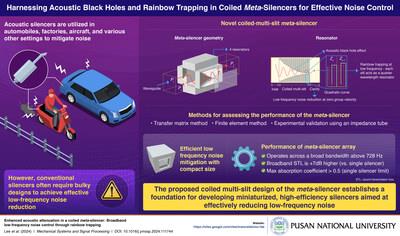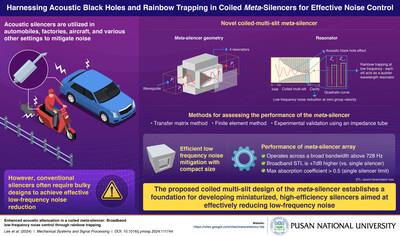
Pusan National University Researchers Propose A Novel Compact Meta-Silencer Design
BUSAN, South Korea, Sept. 12, 2024 /PRNewswire/ -- Chronic low-frequency noise from vehicles, appliances, and industries takes a toll on mental health, causing stress and anxiety. Traditional acoustic silencers require bulky designs to achieve effective noise reduction at low frequencies.
Continue Reading
Pusan National University researchers developed a novel meta-silencer that reduced broadband low-frequency noise by leveraging the acoustic black hole and rainbow trapping effects, resulting in compact and efficient systems for low-frequency noise reduction.
Recent advances in acoustic metamaterials utilize the slow-wave effect and have shown promise for reducing low-frequency noise with more compact designs. Notable among them are devices capable of generating acoustic black holes (ABH) continuously slowing down sound waves until their velocities reach zero. Another alternative is acoustic rainbow trapping (RT), where sound waves are confined to specific paths within a structure, separating and trapping different frequencies at distinct locations.
Leveraging these effects, a research team from Pusan National University in South Korea, led by Professor Kyungjun Song of the Department of Mechanical Engineering, developed an innovative coiled meta-silencer. "Our meta-silencer features a compact design with four parallel resonators, each containing a coiled multi-slit that utilizes the ABH and RT mechanisms for efficient low-frequency noise reduction," explains Prof. Song. Their study was made available online on July 31, 2024, and was published in Volume 222 of Mechanical Systems and Signal Processing on 1 January 2025.
The meta-silencer design features four resonators placed in parallel around a cubical waveguide. Each resonator consists of three sections: an internal cavity, a multi-slit, and an inlet. The multi-slit featured slits placed at the top and bottom of the resonator in a quadratic, horn-like profile, widening at the inlet and gradually narrowing towards the cavity, progressively changing the acoustic impedance, facilitating the ABH effect. Additionally, as frequency increases, the multi-slits act as independent resonators based on frequency, giving rise to the RT effect. Since the RT effect shows an inverse relationship between slit length and frequency, the researchers implemented a coiled-up slit design to achieve efficient RT at low frequencies.
The researchers developed three different resonator designs categorized by slit length, and evaluated their performance using simulations and experimental validation. Model 1 featured straight slits, while Model 2 had a top slit 1.3 times longer and a bottom slit 0.7 times shorter than those of Model 1. Model 3 incorporated a coiled-up slit structure
from the Model 2's structure.
Results showed that the meta-silencer operated in three main sound-blocking modes: a foundational plane wave mode, the multiple-slit localized mode induced by the ABH effect, and the single-slit localized mode generated by the RT effect. Incorporation of coiled-up slits in Model 3 enhanced its performance by shifting the frequency at which sound wave velocities reached zero to 728 Hz. Additionally, it achieved an average experimental sound transmission loss (STL) of 6.73 decibels (dB) across a broad 200–1800 Hertz (Hz) band and an absorption coefficient of 0.49. The researchers also designed a dual-series array meta-silencer, comprising two meta-silencers arranged back-to-back, which nearly doubled the average STL to 13.07 dB and the maximum absorption coefficient to 0.9.
"Unlike traditional large-scale silencers, our compact meta-silencer can be directly integrated into miniaturized machines and narrow spaces, providing targeted low-frequency noise reduction at the source. This technology can improve the quality of life by reducing noise in urban areas, aviation, and industry. We hope to bring this technology to market within 2 to 3 years, with prototype development and testing currently in progress," concludes a hopeful Prof. Song.
Reference
Title of original paper:
Enhanced acoustic attenuation in a coiled
meta-silencer: Broadband low-frequency noise control through rainbow trapping
Journal:
Mechanical Systems and Signal Processing
DOI:
href="" rel="nofollow" 1016/j.2024.11174
About the institute
Website:
Contact:
Goon-Soo Kim
82 51 510 7928
[email protected]
SOURCE Pusan National University
WANT YOUR COMPANY'S NEWS FEATURED ON PRNEWSWIRE? 440k+Newsrooms &
Influencers 9k+
Digital Media
Outlets 270k+
Journalists
Opted In GET STARTED

Legal Disclaimer:
MENAFN provides the
information “as is” without warranty of any kind. We do not accept
any responsibility or liability for the accuracy, content, images,
videos, licenses, completeness, legality, or reliability of the information
contained in this article. If you have any complaints or copyright
issues related to this article, kindly contact the provider above.














Comments
No comment